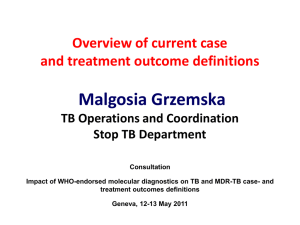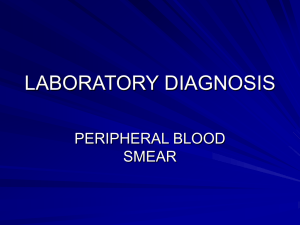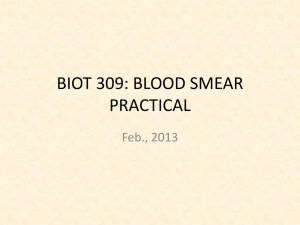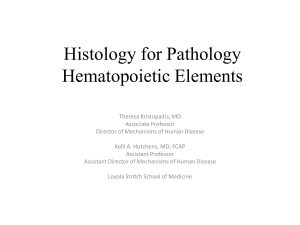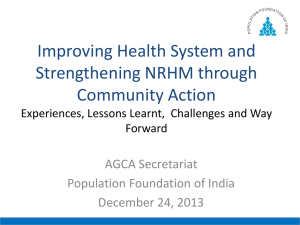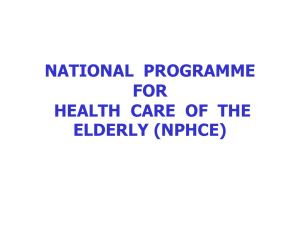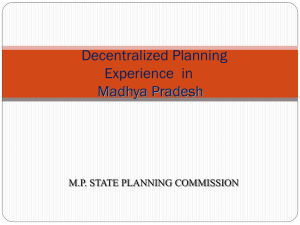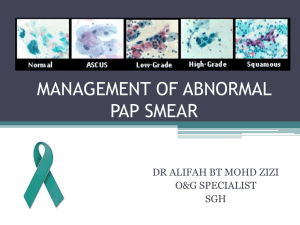TB_State_Health_Secretaries_(12-09
advertisement
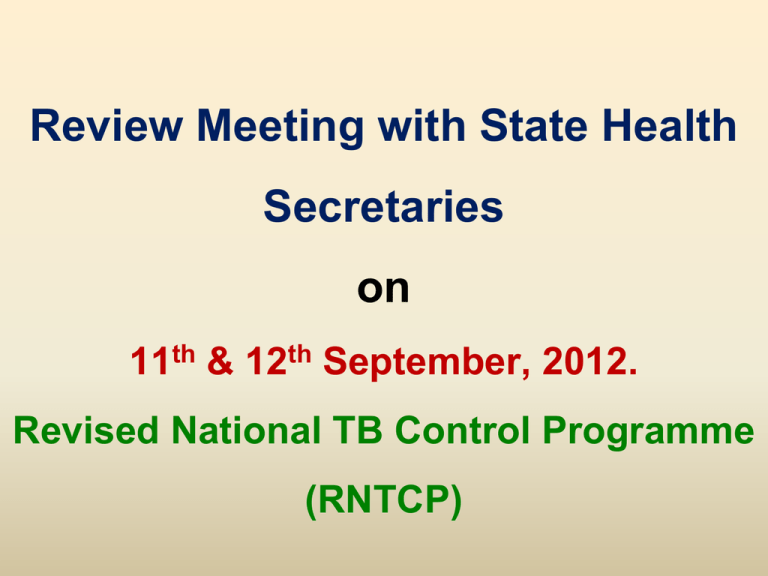
Review Meeting with State Health Secretaries on 11th & 12th September, 2012. Revised National TB Control Programme (RNTCP) RNTCP - Components of DOTS Strategy (Directly Observed Treatment- Shortcourse) • Political commitment • Diagnosis by microscopy • Adequate supply of Short Course drugs • Directly Observed Treatment • Accountability TB Register RNTCP – Goal and Objectives • Goal – To decrease mortality and morbidity due to TB and cut transmission of infection until TB ceases to be a major public health problem in India. • Objectives: – To achieve and maintain a case detection of at least 70% of new sputum positive TB patients – To achieve and maintain a cure rate of at least 85% in newly detected smear positive cases Moving towards Universal Access i.e. detection of 90% of all estimated TB cases (including Drug Resistant & HIV-TB) in the community and successful treatment of at least 90% of the TB patients registered. State-wise New Sputum Positive Case Detection Rate & Treatment Success Rate State-wise Performance (2011) New Smear Positive Case Detection Rate (NSP CDR) Performance States Good A &N , AP, Arunachal Pradesh, Chandigarh, (NSP CDR >= 70%) Delhi, Gujarat, HP, Jharkhand, Meghalaya, (15 states/UTs) Nagaland, Rajasthan, Sikkim, UP, Puducherry Moderate Chhattisgarh, D & N Haveli, Goa, Haryana, (NSP CDR 50 - 70%) J&K, Karnataka, Kerala, MP, Maharashtra, (18 states/UTs) Manipur, Mizoram, Orissa, TN, Tripura, Uttarakhand, Punjab, Assam, West Bengal Poor (NSP CDR < 50%) (3 states/Uts) Bihar, Daman and Diu, Lakshadweep State-wise Performance (2010) New Smear Positive Treatment Success Rate (NSP TSR) Performance States Good (NSP TSR >= 85%) (27 states/UTs) AP, Arunachal Pradesh, Chandigarh, Delhi, Gujarat, HP, Jharkhand, Nagaland, Rajasthan, UP, Puducherry, Chhattisgarh, Haryana, J&K, MP, Maharashtra, Manipur, Mizoram, Orissa, TN, Tripura, Uttarakhand, Punjab, West Bengal, Bihar, Daman and Diu, Lakshadweep. Poor (NSP TSR < 85%) (8 states/Uts) Sikkim, D & N Haveli, Karnataka, A &N , Assam, Meghalaya, Goa, Kerala, New TB Case Detection during 2011 v/s 2010 27 States/UTs have shown a decline/no improvement in New TB Case Detection in 2011 v/s 2010 Relatively better performing States States/UTs A&N Islands Andhra Pradesh Arunachal Pradesh Assam Bihar Chandigarh Chhattisgarh D & N Haveli Daman & Diu Delhi Goa Gujarat Haryana Himachal Pradesh Jammu & Kashmir Jharkhand Karnataka Kerala No. of Districts 1 24 14 24 38 1 16 1 2 25 2 30 21 12 14 24 31 14 No. of Districts with NSP Case Detection Rate (2011) >=70% 50-70% <50% 1 19 8 6 2 0 3 1 0 17 2 18 8 4 6 11 13 3 0 4 5 8 12 1 7 0 2 8 0 10 11 4 6 11 16 5 0 1 1 10 24 0 6 0 0 0 0 2 2 4 2 2 2 6 States/UTs Lakshadweep Madhya Pradesh Maharashtra Manipur Meghalaya Mizoram Nagaland Orissa Puducherry Punjab Rajasthan Sikkim Tamil Nadu Tripura Uttar Pradesh Uttarakhand West Bengal Grand Total No. of Districts 1 50 55 9 7 8 11 31 1 20 33 4 31 4 71 13 19 662 No. of Districts with NSP Case Detection Rate (2011) >=70% 50-70% <50% 1 15 11 3 2 5 3 9 0 9 21 1 5 2 34 6 3 252 0 17 27 4 1 2 4 15 0 10 10 3 19 2 36 6 8 274 0 18 17 2 4 1 4 7 1 1 2 0 7 0 1 1 8 136 States/UTs A&N Islands Andhra Pradesh Arunachal Pradesh Assam Bihar Chandigarh Chhattisgarh D & N Haveli Daman & Diu Delhi Goa Gujarat Haryana Himachal Pradesh Jammu & Kashmir Jharkhand Karnataka Kerala No. of Districts with NSP Treatment Success Rate (2010) Total no. of Districts >=85% 75-85% <75% 1 24 14 24 38 1 16 1 2 25 2 30 21 12 14 24 31 14 0 23 9 7 29 1 10 0 2 12 1 28 14 12 13 19 9 3 1 1 4 15 9 0 5 1 0 12 1 2 7 0 1 5 21 11 0 0 1 2 0 0 1 0 0 1 0 0 0 0 0 0 1 0 States/UTs Lakshadweep Madhya Pradesh Maharashtra Manipur Meghalaya Mizoram Nagaland Orissa Puducherry Punjab Rajasthan Sikkim Tamil Nadu Tripura Uttar Pradesh Uttarakhand West Bengal Grand Total No. of Districts 1 50 55 9 7 8 11 31 1 20 33 4 31 4 71 13 19 662 No. of Districts with NSP Treatment Success Rate (2010) >=85% 75-85% <75% 1 46 30 8 4 5 11 23 1 18 33 2 20 3 68 11 10 485 0 4 23 1 2 3 0 7 0 2 0 1 11 1 3 2 9 166 0 0 2 0 1 0 0 1 0 0 0 1 0 0 0 0 0 11 Uttar Pradesh: District-wise Annual New Smear Positive Case Detection Rate in 2011 Uttar Pradesh: District-wise Annual New Smear Positive Treatment Success Rate in 2010 Madhya Pradesh: District-wise Annual New Smear Positive Case Detection Rate in 2011 Madhya Pradesh: District-wise Annual New Smear Positive Treatment Success Rate in 2010 Bihar: District-wise Annual New Smear Positive Case Detection Rate in 2011 Bihar: District-wise Annual New Smear Positive Treatment Success Rate in 2010 Maharashtra: District-wise Annual New Smear Positive Case Detection Rate in 2011 Maharashtra: District-wise Annual New Smear Positive Treatment Success Rate in 2010 Tamil Nadu: District-wise Annual New Smear Positive Case Detection Rate in 2011 Tamil Nadu: District-wise Annual New Smear Positive Treatment Success Rate in 2010 Orissa: District-wise Annual New Smear Positive Case Detection Rate in 2011 Orissa: District-wise Annual New Smear Positive Treatment Success Rate in 2010 Punjab: District-wise Annual New Smear Positive Case Detection Rate in 2011 Punjab: District-wise Annual New Smear Positive Treatment Success Rate in 2010 Status of PMDT Services (Programmatic Management of Drug-Resistant TB) PMDT Services introduced in Aug 2007 All 35 State/UTs have introduced PMDT services of which 18 have achieved complete geographical coverage 802 million (65%) pop have access to services across 435 districts 67 DR-TB Centers are functional 0-25% 26-50% 51-75% 76-99% 100% Certified : N=42 Culture & Drug Sensitivity Testing (DST) Labs Network JAMMU & KAS HMIR 29 RNTCP supported labs HIMACHAL P RADE SH 13 Additional PUNJAB HARYANA NDTC AIIMS-2 LRS CHD UTTARAKHAND ARUNACHAL PRADE SH HARYANA DELHI Gurgaon RAJASTHAN SIKKIM UTTAR PRADE SH JALMA BIH AR ASS AM NAGALAND MEGHALAYA MANIPUR JHARKHAND GUJARAT TRIPURA WEST BENGAL MADHYA P RADE SH MIZORAM CHHATIS GARH ORIS SA MAHARASHTRA ANDHRA PRADE SH GOA KARNATAKA Technology - Solid culture:34 - Line Probe Assay: 29 - Liquid Culture:10 TRC NTI PO NDIC HERR Y TAMIL NADU KERALA IRL (Certified ) IRL (Under Certification) IRL (Equipment's being procured) Med Col / NGO / Private Labs (Certified) Med Col / NGO / Private Labs (Under Certification ) Med Col / NGO / Private Labs (Preparatory) National Reference Labs Critical Gaps in PMDT 1. State PMDT Committee meetings not held regularly 2. Slow scale up of PMDT services in few states • UP (15%), ASSAM (16%), BIHAR (22%), KA (31%), MP (54%) 3. Laboratory capacity limited • UP (2), WB (2), KA (2), RJ (2), MP (3), BI (0), PB (0), HP (0), JK (0) 4. Deficit of DR TB Centers against norm (1/10million population) with service gaps • UP (2/20), BI (1/11), MP (2), KA (1/6), TN (3/7), WB (3/9), AS (1/3), HR (1/3), CG (1/2) 5. High % of confirmed MDR TB Cases not put on treatment in 2012 • WB (48%), MH (40%), RJ (28%), HP (35%), HR (28%), GU (27%) Action Points (1) • Strengthening the quality of basic DOTS services – Ensure sanctioned posts are filled and all staff trained. – Ensure availability of quality diagnostic and treatment services. – Ensure availability of free X-Ray services linked with all facilities. – Ensure quality drug supply for first-line, 2nd line ATT drugs and antibiotics. – Bringing services closer to the community with the help of ANM, MPW, ASHA. • Strengthening supervision and monitoring – Use COMPOSITE INDICATORS – Implement Focused Action Plan in Under-performing Districts – Use of online case-based reporting system for data entry. • Identifying areas with low suspect examination and prioritize case finding Action Points (2) • Promoting community screening of suspects and referral. • TB diagnosis and treatment facilities at all Nutritional Rehabilitation Centers (NRCs). • Referral linkages for diagnosis of EP-TB cases. • Focused attention for Urban areas. • Expanding efforts to engage all care providers. – Innovative approaches to engage the private sector. – Need based involvement with accountability. – Timely payment of dues. • Active case finding in high risk population TB-HIV, TB-Diabetes. Action Points for PMDT - (1) 1. State PMDT Committee meetings to be held every quarter to review progress and address local challenges 2. Expedite 100% coverage to PMDT services in the states by Dec ’12 • Complete – establishment of DR-TB centers, Labs and Drug Stores upgrades, Staffing & Trainings, Central Appraisals in remaining districts 3. Expedite lab capacity enhancement to enable move towards universal DST • Complete – Civil works, equipment installation & AMC, power backup, HR, proficiency testing in various technologies in all remaining labs in the states. Action Points for PMDT – (2) 4. Expedite scale up of DR TB Centres (norm @ 1/10 million population) • Upgrade for airborne infection control, provide nurses and ward attendants • Free beds, investigations, ancillary drugs, food etc. 5. Improve coordination b/w labs, districts, field staff and DR TB centre for prompt treatment of confirmed MDR TB cases in the states RNTCP - Newer Initiatives All States/UTs need to ensure all out efforts towards implementation of – 1. TB Notification Order dated 7th May 2012. 2. Patient-wise data entry in “Nikshay” for all TB cases detected with effect from 1st January 2012 (Case Based Web Based Recording & Reporting System). 3. The Gazette Notification dated 7th June 2012 on the banning the import, manufacture, sale, distribution and use of “ All Serological Tests for TB Diagnosis”. 4. Enforcement of Schedule H – All ANTI-TB drugs are under Schedule H (i.e. should be sold only on the prescription of registered medical practitioner). NIKSHAY (Case Based Web Based Recording & Reporting System) www.tbcindia.nic.in Assam – District wise Annual New Smear Positive Case Detection Rate, 2011 (in %age) Assam – District wise Annual New Smear Positive Treatment Success Rate, 2010 (in %age) Jharkhand – District wise Annual New Smear Positive Case Detection Rate, 2011 (in %age) Jharkhand – District wise Annual New Smear Positive Treatment Success Rate, 2010 (in %age) West Bengal – District wise Annual New Smear Positive Case Detection Rate, 2011 (in %age) West Bengal – District wise Annual New Smear Positive Treatment Success Rate, 2010 (in %age) Chhattisgarh – District wise Annual New Smear Positive Case Detection Rate, 2011 (in %age) Chhattisgarh – District wise Annual New Smear Positive Treatment Success Rate, 2010 (in %age) Karnataka – District wise Annual New Smear Positive Case Detection Rate, 2011 (in %age) Karnataka – District wise Annual New Smear Positive Treatment Success Rate, 2010 (in %age) Action Points (3) • Improving communication and outreach. – focused strategies, targeting hard-to-reach groups. – innovative communications strategies to generate demand from patients, and – improving cooperation from the private sector. • State and District TB-HIV Coordination Committee Meetings not being conducted regularly in many States/Districts, the frequency of which should be ensured. Airborne Infection Control – (1) • National Guidelines for Airborne Infection Control in Health Care and Other settings developed and disseminated (available on www.tbcindia.nic.in ) that covers Managerial responsibilities at State, District and Facility level Administrative, Environmental & Engineering, Personal Protective Controls Infection control measures at congregate and community level • Prioritized implementation across DR TB Centres and TB C-DST Laboratories. Airborne Infection Control – (2) • Pilot implementation to assess operational feasibility underway at 35 health care facilities (Primary to Tertiary care including 10 ART centres) in 3 states (GU, AP, WB) • Pilot results will guide refinement of the national guidelines • Future scale up of the guidelines implementation proposed through integration with NRHM, NCDC & NIHFW with technical support from CTD in Capacity building of state teams Integration as a chapter in the Infection Control Plans and Strategies of Health care facilities.

